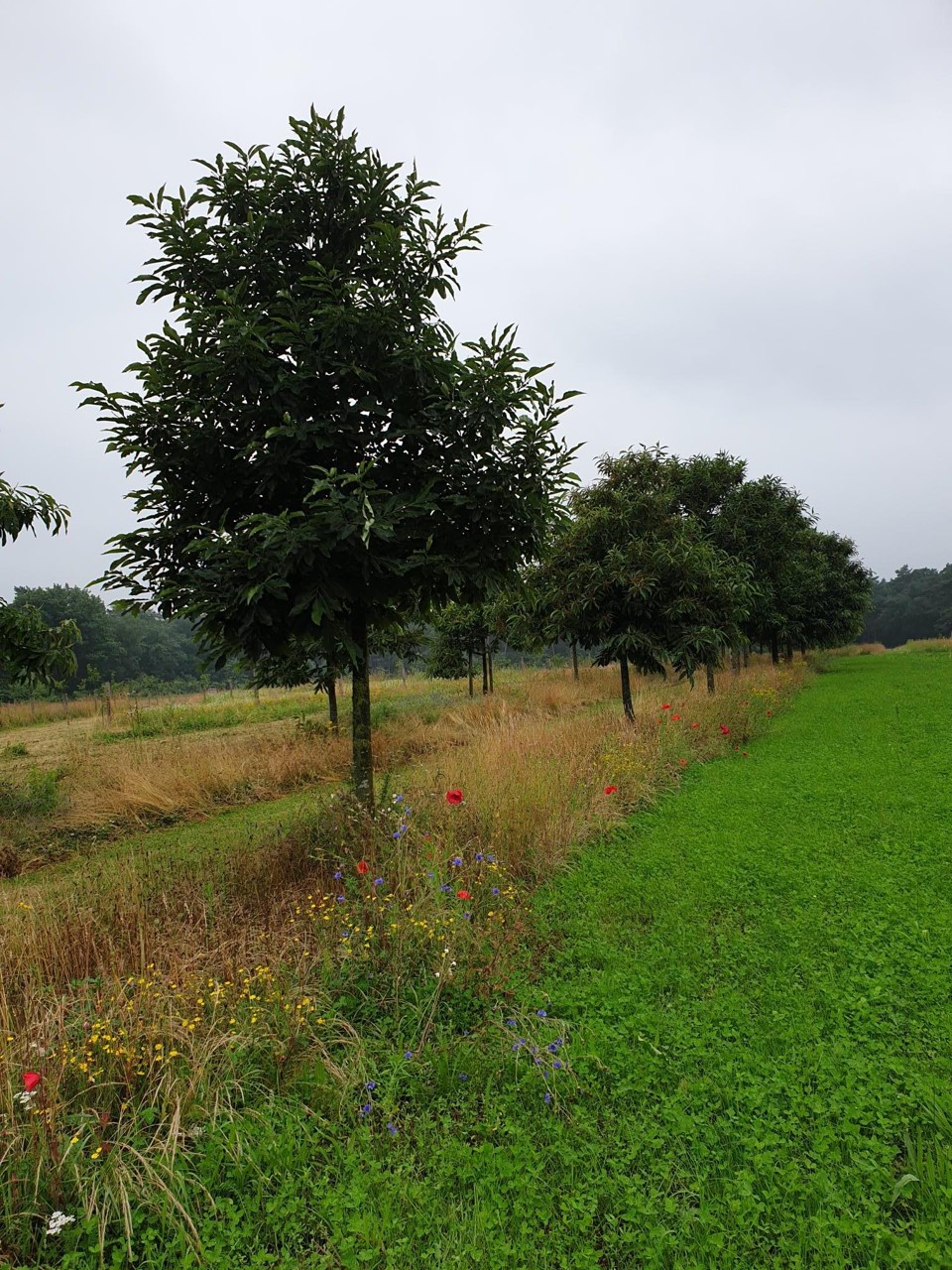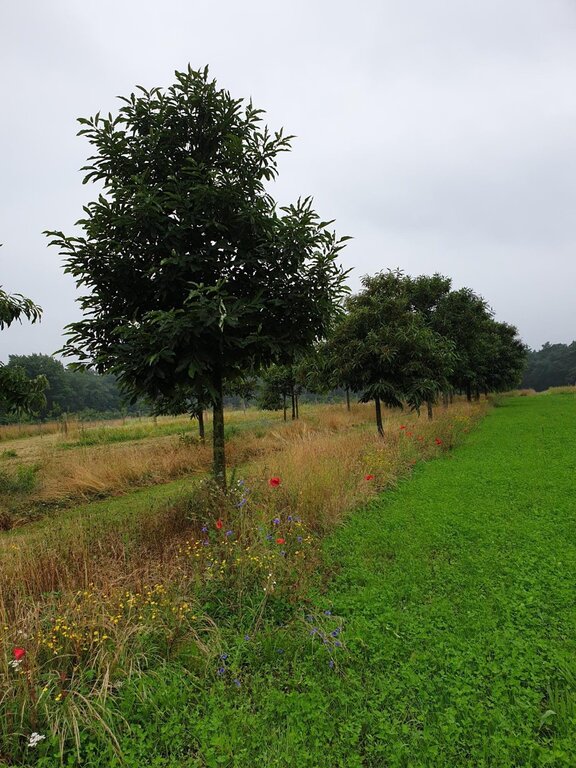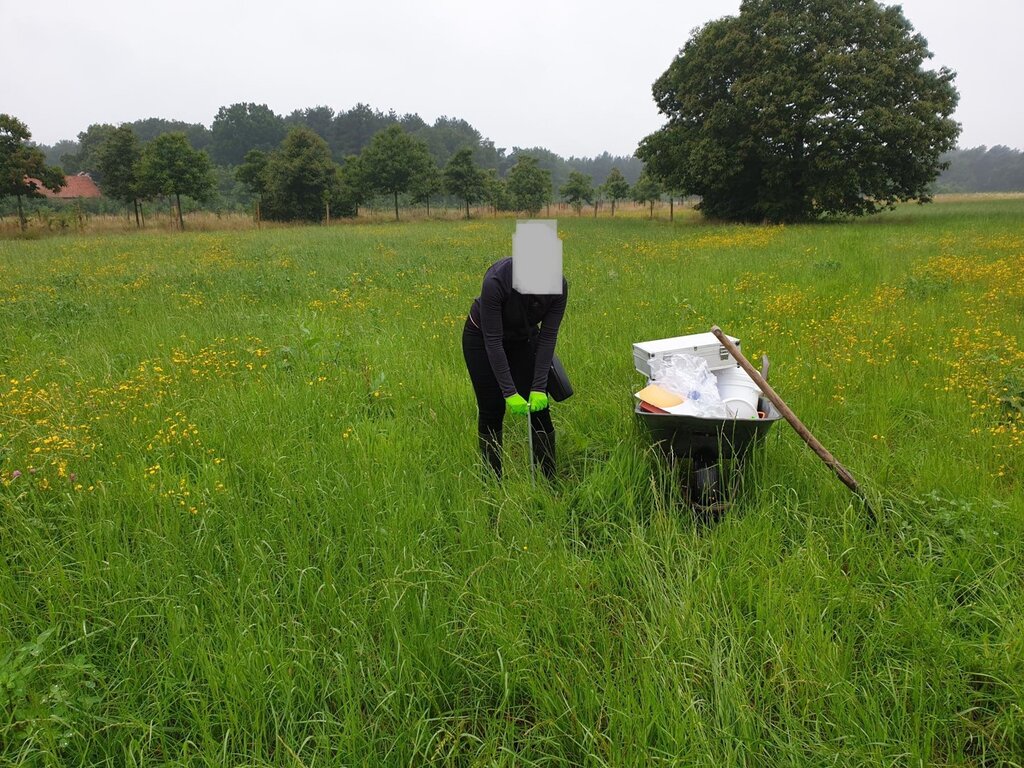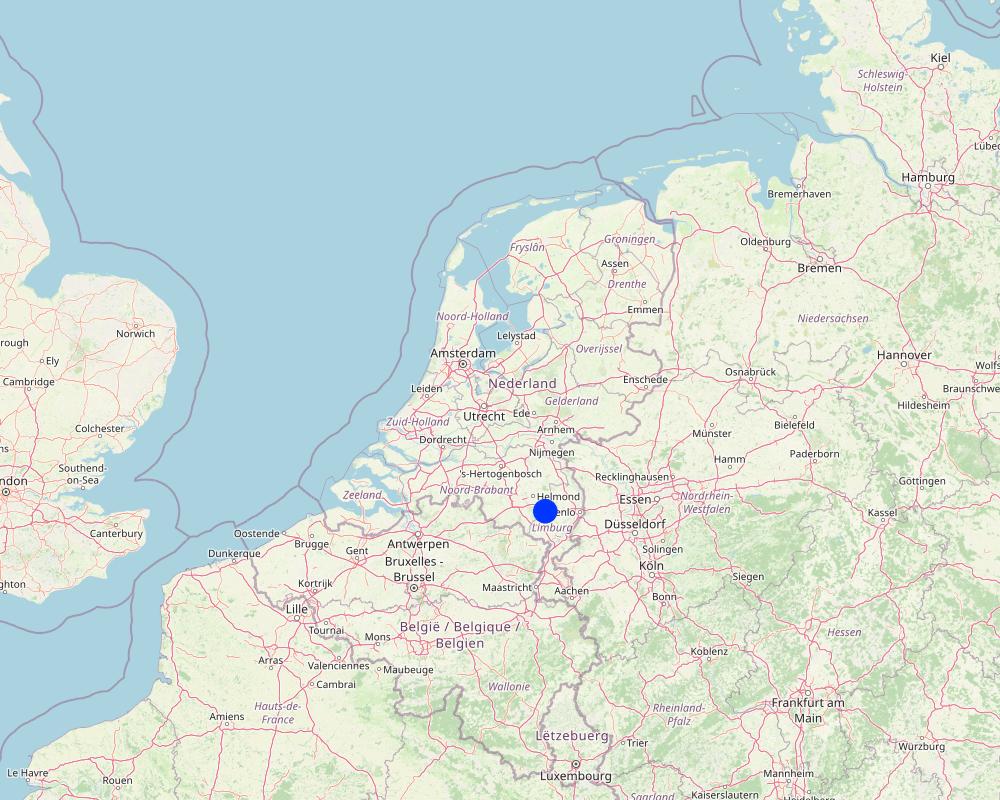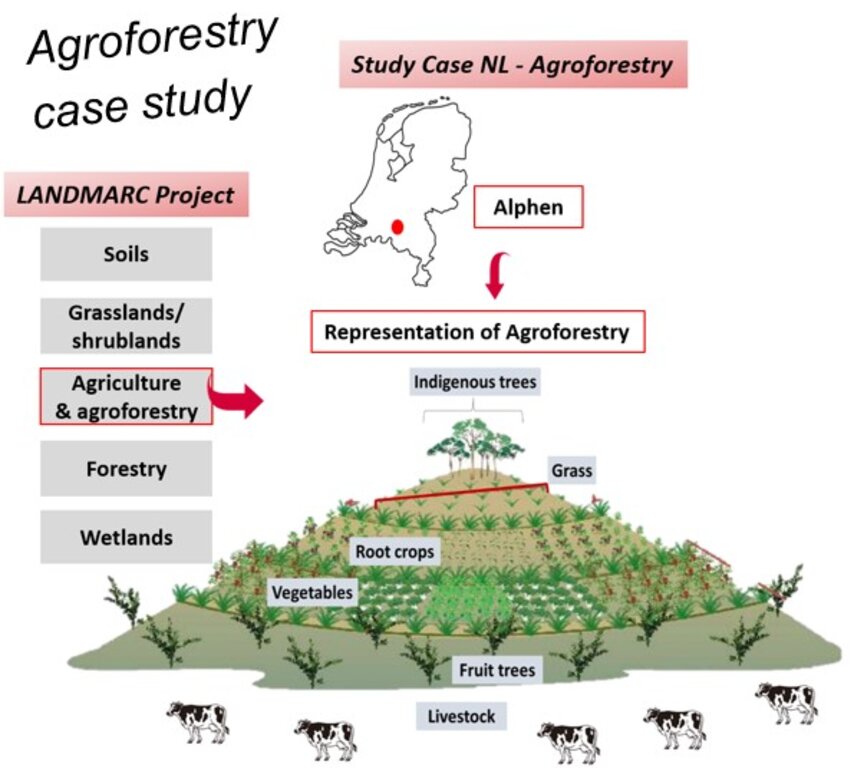Alley cropping with nut trees [เนเธอร์แลนด์]
- ผู้สร้างสรรค์:
- การอัพเดท:
- ผู้รวบรวม: Carlos Gil Picon
- ผู้เรียบเรียง: –
- ผู้ตรวจสอบ: Rima Mekdaschi Studer, William Critchley
Alley cropping with nut trees
technologies_7094 - เนเธอร์แลนด์
ดูส่วนย่อย
ขยายทั้งหมด ย่อทั้งหมด1. ข้อมูลทั่วไป
1.2 รายละเอียดที่ติดต่อได้ของผู้รวบรวมและองค์กรที่เกี่ยวข้องในการประเมินและการจัดเตรียมทำเอกสารของเทคโนโลยี
วิทยากรหลัก
ผู้เชี่ยวชาญ SLM:
Gil Picon Carlos
Stichting Joint Implementation Network
เนเธอร์แลนด์
ชื่อของโครงการซึ่งอำนวยความสะดวกในการทำเอกสารหรือการประเมินเทคโนโลยี (ถ้าเกี่ยวข้อง)
Land Use Based Mitigation for Resilient Climate Pathways (LANDMARC)ชื่อขององค์กรซึ่งอำนวยความสะดวกในการทำเอกสารหรือการประเมินเทคโนโลยี (ถ้าเกี่ยวข้อง)
JIN Climate and Sustainability (JIN-NGO) - เนเธอร์แลนด์1.3 เงื่อนไขการใช้ข้อมูลที่ได้บันทึกผ่านทาง WOCAT
ผู้รวบรวมและวิทยากรหลักยอมรับเงื่อนไขเกี่ยวกับการใช้ข้อมูลที่ถูกบันทึกผ่านทาง WOCAT:
ใช่
1.4 การเปิดเผยเรื่องความยั่งยืนของเทคโนโลยีที่ได้อธิบายไว้
เทคโนโลยีที่ได้อธิบายไว้นี้เป็นปัญหาของความเสื่อมโทรมโทรมของที่ดินหรือไม่ จึงไม่ได้รับการยอมรับว่าเป็นเทคโนโลยีเพื่อการจัดการที่ดินอย่างยั่งยืน:
ไม่ใช่
2. การอธิบายลักษณะของเทคโนโลยี SLM
2.1 การอธิบายแบบสั้น ๆ ของเทคโนโลยี
คำจำกัดความของเทคโนโลยี:
An agroforestry system consisting of rows of walnut and hazelnut trees combined with grassland and flowers was applied in place of a former conventional monoculture system in Alphen, Noord-Brabant, the Netherlands.
2.2 การอธิบายแบบละเอียดของเทคโนโลยี
คำอธิบาย:
This agroforestry technology is applied on an organic farm located in the province of Noord-Brabant, Netherlands. Owned by a local farmer, the farm covers a total of 7.8 hectares. In 2018, this land was allocated for the Farm Life project, transforming it into agroforestry system. The farm integrates natural and agricultural elements, creating a sustainable environment where trees (chestnuts), crops, and pasture co-exist.
The agroforestry system on this farm is utilized for multiple purposes, including chestnut tree cultivation, agriculture, horticulture, and pasture. This diverse planting strategy allows the farmer to mix crop production with tree cultivation, where each component supports soil health and ecological balance. Chestnut trees, for example, are grown alongside mainly grasses, introducing perennial elements to the farm and diversifying the landscape.
Agroforestry merges natural ecosystems with agriculture, creating a system where nature actively enhances farm productivity. It allows farmers to move beyond monoculture farming by incorporating trees and shrubs into crop systems, promoting biodiversity as an essential part of farming. For example, integrating chestnut trees into these systems improves soil health, reduces erosion (as these are mainly sandy soils), and strengthens the farm’s resilience to environmental stress. This approach also creates income from products like chestnuts, which supports sustainable food production—a primary motivation for the farmer.
This agroforestry system, while beneficial, faces challenges in implementation and scaling-up. For example, perennial food crops are not yet commonly integrated into modern agroforestry systems, which limits their full potential. Establishing a guide on cultivation practices and securing better funding would be key steps to upscaling agroforestry production and making it more accessible. Additionally, adequate resources and guidance on plant selection, tree management, and harvesting methods would make it easier for farmers to adopt and sustain these practices.
Specifically to this agroforestry, compared to traditional fruit trees like apples and pears, chestnut trees require less intensive management—reducing labor as they naturally drop fruit and need less pruning. They also enhance biodiversity and can be financially beneficial. As a perennial carbohydrate source, chestnuts offer a sustainable, low-maintenance crop option that aligns with modern food production goals. Additionally, they can help revitalize traditional orchard landscapes and accelerate returns from forest areas through nut production, contributing to long-term ecological and economic benefits.
While agroforestry offers many environmental benefits, land users face several challenges. Initial investments in tree planting, maintenance, and management can be costly, and limited access to financial support often discourages smallholder farmers from adopting these practices. Some farmers also find the high diversity of species in agroforestry systems to be complex and challenging for achieving consistent product yields. There are also limitations in technology suited for small-scale agroforestry, such as a shortage of plant materials (e.g., seedlings) and limited guidance on establishing and maintaining agroforestry systems. On the positive side, farmers appreciate agroforestry’s contributions to a sustainable environment. The increased organic matter and diversity, improve soil health and crop productivity, and build resilience against environmental stressors, which makes agroforestry an option for long-term land management.
2.3 รูปภาพของเทคโนโลยี
2.5 ประเทศภูมิภาค หรือสถานที่ตั้งที่เทคโนโลยีได้นำไปใช้และได้รับการครอบคลุมโดยการประเมินนี้
ประเทศ:
เนเธอร์แลนด์
ภูมิภาค/รัฐ/จังหวัด:
Noord-Brabant
ข้อมูลจำเพาะเพิ่มเติมของสถานที่ตั้ง :
Alphen
ระบุการกระจายตัวของเทคโนโลยี:
- กระจายไปอย่างสม่ำเสมอในพื้นที่
If the Technology is evenly spread over an area, specify area covered (in km2):
0.078
Is/are the technology site(s) located in a permanently protected area?
ไม่ใช่
Map
×2.6 วันที่การดำเนินการ
ถ้าไม่รู้ปีที่แน่นอน ให้ระบุวันที่โดยประมาณ:
- น้อยกว่า 10 ปี (ไม่นานนี้)
2.7 คำแนะนำของเทคโนโลยี
ให้ระบุว่าเทคโนโลยีถูกแนะนำเข้ามาอย่างไร:
- ด้วยการริเริ่มของผู้ใช้ที่ดินเอง
3. การจัดประเภทของเทคโนโลยี SLM
3.1 วัตถุประสงค์หลักของเทคโนโลยี
- ลด ป้องกัน ฟื้นฟู การเสื่อมโทรมของที่ดิน
- อนุรักษ์ระบบนิเวศน์
- ปรับตัวเข้ากับการเปลี่ยนแปลงภูมิอากาศของโลก สภาพภูมิอากาศที่รุนแรงและผลกระทบ
- ชะลอการเปลี่ยนแปลงภูมิอากาศของโลกและผลกระทบ
3.2 ประเภทของการใช้ที่ดินในปัจจุบันที่ได้นำเทคโนโลยีไปใช้
Land use mixed within the same land unit:
ใช่
Specify mixed land use (crops/ grazing/ trees):
- วนเกษตร (Agroforestry)

พื้นที่ปลูกพืช
- การปลูกไม้ยืนต้น ไม้พุ่ม
Tree and shrub cropping - Specify crops:
- tree nuts (brazil nuts, pistachio, walnuts, almonds, etc.)
จำนวนของฤดูเพาะปลูกต่อปี:
- 1
Is intercropping practiced?
ใช่
Is crop rotation practiced?
ไม่ใช่

ทุ่งหญ้าเลี้ยงสัตว์
Animal type:
- cattle - dairy
ผลิตภัณฑ์และบริการ:
- milk

อื่น ๆ
ระบุ:
flowers
3.3 Has land use changed due to the implementation of the Technology?
Has land use changed due to the implementation of the Technology?
- Yes (Please fill out the questions below with regard to the land use before implementation of the Technology)

พื้นที่ปลูกพืช
- การปลูกพืชล้มลุกอายุปีเดียว
Annual cropping - Specify crops:
- root/tuber crops - potatoes
Is intercropping practiced?
ไม่ใช่
Is crop rotation practiced?
ไม่ใช่
3.4 การใช้น้ำ
การใช้น้ำของที่ดินที่มีการใช้เทคโนโลยีอยู่:
- จากน้ำฝน
3.5 กลุ่ม SLM ที่ตรงกับเทคโนโลยีนี้
- การปลูกป่าร่วมกับพืช
3.6 มาตรการ SLM ที่ประกอบกันเป็นเทคโนโลยี

มาตรการอนุรักษ์ด้วยวิธีพืช
- V1: ต้นไม้และพุ่มไม้คลุมดิน
- V2: หญ้าและไม้ยืนต้น

มาตรการอนุรักษ์ด้วยการจัดการ
- M1: การเปลี่ยนรูปแบบของการใช้ประโยชน์ที่ดิน
3.7 รูปแบบหลักของการเสื่อมโทรมของที่ดินที่ได้รับการแก้ไขโดยเทคโนโลยี

การกัดกร่อนของดินโดยน้ำ
- Wt (Loss of topsoil): การสูญเสียดินชั้นบนหรือการกัดกร่อนที่ผิวดิน

การเสื่อมโทรมของดินทางด้านชีวภาพ
- Bh (Loss of habitat): การสูญเสียแหล่งที่อยู่
- Bp (Increase of pests/diseases): การเพิ่มขึ้นของศัตรูพืชและโรคพืช

การเสื่อมโทรมของน้ำ
- Hq (Decline of groundwater quality): การลดลงของคุณภาพน้ำบาดาล
แสดงความคิดเห็น:
The implementation of agroforestry in this case study intends to increase soil properties by restoring soil biological cycles, providing habitat for predators that can reduce pests, and reduce nitrate leaching to improve nutrient retention and avoid the leaching of nitrates.
3.8 การป้องกัน การลดลง หรือการฟื้นฟูความเสื่อมโทรมของที่ดิน
ระบุเป้าหมายของเทคโนโลยีกับความเสื่อมโทรมของที่ดิน:
- ป้องกันความเสื่อมโทรมของที่ดิน
- ลดความเสื่อมโทรมของดิน
4. ข้อมูลจำเพาะด้านเทคนิค กิจกรรมการนำไปปฏิบัติใช้ ปัจจัยนำเข้า และค่าใช้จ่าย
4.1 แบบแปลนทางเทคนิคของเทคโนโลยี
ข้อมูลจำเพาะด้านเทคนิค (แบบแปลนทางเทคนิคของเทคโนโลยี):
The system consists of a flat area of around 7.8ha where nut tree alleys have been implemented. The separation between tree lines is about 50 meters, and the separation between trees is around 12 meters.
ผู้เขียน:
Afnan Suleiman and Eline Keuning
วันที่:
15/07/2024
ข้อมูลจำเพาะด้านเทคนิค (แบบแปลนทางเทคนิคของเทคโนโลยี):
This case study consists of 3 plots where agroforestry was implemented; in the first two plots, trees are combined with grasslands and flowers. The combined length of these two plots is 350 meters and the width is 140m. There is a double tree row covering the whole length of the plot, and a combination of trees and shrubs covering the width of the plot and of 60m in length. The area is surrounded by potato cropfields.
The third plot consist on a triangular grass field, with a side length of 200m, with trees on the edges. This plot is approximately 1.6 km from the other two plots
ผู้เขียน:
Afnan Suleiman and Eline Keuning
วันที่:
15/07/2019
4.2 ข้อมูลทั่วไปเกี่ยวกับการคำนวณปัจจัยนำเข้าและค่าใช้จ่าย
ให้ระบุว่าค่าใช้จ่ายและปัจจัยนำเข้าได้รับการคำนวณอย่างไร:
- ต่อพื้นที่ที่ใช้เทคโนโลยี
ระบุขนาดและหน่วยพื้นที่:
7.8 hectares
อื่นๆ หรือสกุลเงินประจำชาติ (ระบุ):
eur
If relevant, indicate exchange rate from USD to local currency (e.g. 1 USD = 79.9 Brazilian Real): 1 USD =:
0.9
ระบุค่าเฉลี่ยของค่าจ้างในการจ้างแรงงานต่อวัน:
200 euro
4.3 กิจกรรมเพื่อการจัดตั้ง
แสดงความคิดเห็น:
Activities and costs not available: our contract was not involved in the financial or other aspects of the implementation
4.4 ค่าใช้จ่ายของปัจจัยนำเข้าที่จำเป็นสำหรับการจัดตั้ง
แสดงความคิดเห็น:
Costs not available; our contract was not involved in the financial aspect of the implementation and, while can provide an overview of the benefits and drawbacks compared to the previous system, cannot provide any figures
4.5 การบำรุงรักษาสภาพหรือกิจกรรมที่เกิดขึ้นเป็นประจำ
แสดงความคิดเห็น:
Activities and costs not available: our contract was not involved in the financial or other aspects of the implementation
4.6 ค่าใช้จ่ายของปัจจัยนำเข้าและกิจกรรมที่เกิดขึ้นเป็นประจำที่ต้องการการบำรุงรักษา (ต่อปี)
แสดงความคิดเห็น:
Costs not available; our contract was not involved in the financial aspect of the implementation and, while can provide an overview of the benefits and drawbacks compared to the previous system, cannot provide any figures
5. สิ่งแวดล้อมทางธรรมชาติและของมนุษย์
5.1 ภูมิอากาศ
ฝนประจำปี
- < 250 ม.ม.
- 251-500 ม.ม.
- 501-750 ม.ม.
- 751-1,000 ม.ม.
- 1,001-1,500 ม.ม.
- 1,501-2,000 ม.ม.
- 2,001-3,000 ม.ม.
- 3,001-4,000 ม.ม.
- > 4,000 ม.ม.
ระบุปริมาณน้ำฝนเฉลี่ยรายปี (ถ้ารู้) :หน่วย ม.ม.
762.00
ข้อมูลจำเพาะ/ความคิดเห็นเรื่องปริมาณน้ำฝน:
Rainfall in the area is well distributed during the year, with eventual but often not severe drought periods during the summer
ระบุชื่อของสถานีตรวดวัดอากาศที่ใช้อ้างอิงคือ:
Gemert-Bakel
เขตภูมิอากาศเกษตร
- กึ่งชุ่มชื้น
well distributed rainfall and relatiely mild temperatures, although mean minimum temperatures are below 6.5 degrees during 6 months per year
5.2 สภาพภูมิประเทศ
ค่าเฉลี่ยความลาดชัน:
- ราบเรียบ (0-2%)
- ลาดที่ไม่ชัน (3-5%)
- ปานกลาง (6-10%)
- เป็นลูกคลื่น (11-15%)
- เป็นเนิน (16-30%)
- ชัน (31-60%)
- ชันมาก (>60%)
ธรณีสัณฐาน:
- ที่ราบสูง/ที่ราบ
- สันเขา
- ไหล่เขา
- ไหล่เนินเขา
- ตีนเนิน
- หุบเขา
ระดับความสูง:
- 0-100 เมตร
- 101-500 เมตร
- 501-1,000 เมตร
- 1,001-1,500 เมตร
- 1,501-2,000 เมตร
- 2,001-2,500 เมตร
- 2,501-3,000 เมตร
- 3,001-4,000 เมตร
- > 4,000 เมตร
ให้ระบุถ้าเทคโนโลยีได้ถูกนำไปใช้:
- ไม่เกี่ยวข้อง
5.3 ดิน
ค่าเฉลี่ยความลึกของดิน:
- ตื้นมาก (0-20 ซ.ม.)
- ตื้น (21-50 ซ.ม.)
- ลึกปานกลาง (51-80 ซ.ม.)
- ลึก (81-120 ซ.ม.)
- ลึกมาก (>120 ซ.ม.)
เนื้อดิน (ดินชั้นบน):
- ปานกลาง (ดินร่วน ทรายแป้ง)
เนื้อดินล่าง (> 20 ซ.ม.ต่ำจากผิวดิน):
- หยาบ/เบา (ดินทราย)
- ปานกลาง (ดินร่วน ทรายแป้ง)
อินทรียวัตถุในดิน:
- ปานกลาง (1-3%)
(ถ้ามี) ให้แนบคำอธิบายเรื่องดินแบบเต็มหรือระบุข้อมูลที่มีอยู่ เช่น ชนิดของดิน ค่า pH ของดินหรือความเป็นกรดของดิน ความสามารถในการแลกเปลี่ยนประจุบวก ไนโตรเจน ความเค็ม เป็นต้น:
Thick eared soil with an ash cover consisting of sand, a high elevation with respect to groundwater (Gt IV and above) and a black mineral eared layer. The topsoil consists of loamy fine sand.
5.4 ความเป็นประโยชน์และคุณภาพของน้ำ
ระดับน้ำใต้ดิน:
<5 เมตร
น้ำไหลบ่าที่ผิวดิน:
ดี
คุณภาพน้ำ (ที่ยังไม่ได้บำบัด):
เป็นน้ำใช้เพื่อการเกษตรเท่านั้น (การชลประทาน)
Water quality refers to:
both ground and surface water
ความเค็มของน้ำเป็นปัญหาหรือไม่:
ไม่ใช่
กำลังเกิดน้ำท่วมในพื้นที่หรือไม่:
ใช่
บ่อยครั้ง:
เป็นครั้งเป็นคราว
5.5 ความหลากหลายทางชีวภาพ
ความหลากหลายทางชนิดพันธุ์:
- ปานกลาง
ความหลากหลายของแหล่งที่อยู่:
- ปานกลาง
ความคิดเห็นและข้อมูลจำเพาะเพิ่มเติมของความหลากหลายทางชีวภาพ:
Biodiversity in the area is generally low. However, there has been an improvement in bird and fungal biodiversity after the implementation of the technique.
5.6 ลักษณะของผู้ใช้ที่ดินที่นำเทคโนโลยีไปปฏิบัติใช้
อยู่กับที่หรือเร่ร่อน:
- อยู่กับที่
แนวทางการตลาดของระบบการผลิต:
- ทำการค้า/การตลาด
ระดับของความมั่งคั่งโดยเปรียบเทียบ:
- พอมีพอกิน
เป็นรายบุคคล/ครัวเรือน:
- กลุ่ม/ชุมชน
ระดับของการใช้เครื่องจักรกล:
- งานที่ใช้แรงกาย
- การใช้เครื่องจักรหรือเครื่องยนต์
เพศ:
- หญิง
- ชาย
อายุของผู้ใช้ที่ดิน:
- วัยกลางคน
5.7 Average area of land used by land users applying the Technology
- < 0.5 เฮกตาร์
- 0.5-1 เฮกตาร์
- 1-2 เฮกตาร์
- 2-5 เฮกตาร์
- 5-15 เฮกตาร์
- 15-50 เฮกตาร์
- 50-100 เฮกตาร์
- 100-500 เฮกตาร์
- 500-1,000 เฮกตาร์
- 1,000-10,000 เฮกตาร์
- >10,000 เฮกตาร์
พิจารณาว่าเป็นขนาดเล็ก กลาง หรือขนาดใหญ่ (ซึ่งอ้างอิงถึงบริบทระดับท้องถิ่น):
- ขนาดเล็ก
5.8 กรรมสิทธิ์ในที่ดิน สิทธิในการใช้ที่ดินและสิทธิในการใช้น้ำ
กรรมสิทธิ์ในที่ดิน:
- บริษัท
- รายบุคคล ได้รับสิทธิครอบครอง
สิทธิในการใช้ที่ดิน:
- เช่า
- รายบุคคล
สิทธิในการใช้น้ำ:
- เกี่ยวกับชุมชน (ถูกจัดระเบียบ)
Are land use rights based on a traditional legal system?
ไม่ใช่
5.9 การเข้าถึงบริการและโครงสร้างพื้นฐาน
สุขภาพ:
- จน
- ปานกลาง
- ดี
การศึกษา:
- จน
- ปานกลาง
- ดี
ความช่วยเหลือทางด้านเทคนิค:
- จน
- ปานกลาง
- ดี
การจ้างงาน (เช่น ภายนอกฟาร์ม):
- จน
- ปานกลาง
- ดี
ตลาด:
- จน
- ปานกลาง
- ดี
พลังงาน:
- จน
- ปานกลาง
- ดี
ถนนและการขนส่ง:
- จน
- ปานกลาง
- ดี
น้ำดื่มและการสุขาภิบาล:
- จน
- ปานกลาง
- ดี
บริการด้านการเงิน:
- จน
- ปานกลาง
- ดี
6. ผลกระทบและสรุปคำบอกกล่าว
6.1 ผลกระทบในพื้นที่ดำเนินการ (On-site) จากการใช้เทคโนโลยี
ผลกระทบทางด้านเศรษฐกิจและสังคม
ความเป็นประโยชน์และคุณภาพของน้ำ
คุณภาพน้ำดื่ม
แสดงความคิดเห็น/ระบุ:
slight decrease in leached nitrates
รายได้และค่าใช้จ่าย
ค่าใช่จ่ายของปัจจัยการผลิตทางการเกษตร
แสดงความคิดเห็น/ระบุ:
more machinery and labour needed
รายได้จากฟาร์ม
แสดงความคิดเห็น/ระบุ:
through diversification and added value of organic agriculture
ความหลากหลายของแหล่งผลิตรายได้
แสดงความคิดเห็น/ระบุ:
above
ภาระงาน
แสดงความคิดเห็น/ระบุ:
above
ผลกระทบด้านสังคมวัฒนธรรมอื่น ๆ
ความมั่นคงด้านอาหาร / พึ่งตนเองได้
แสดงความคิดเห็น/ระบุ:
through diversification
โอกาสทางวัฒนธรรม
โอกาสทางด้านสันทนาการ
แสดงความคิดเห็น/ระบุ:
slight increase in scenic appeal of the area
สถาบันของชุมชน
แสดงความคิดเห็น/ระบุ:
fosters curiosity of surrounding land users
SLM หรือความรู้เรื่องความเสื่อมโทรมของที่ดิน
แสดงความคิดเห็น/ระบุ:
above
ผลกระทบด้านนิเวศวิทยา
วัฐจักรน้ำหรือน้ำบ่า
คุณภาพน้ำ
แสดงความคิดเห็น/ระบุ:
decreased water run off (low anyway, it's a flat area)
น้ำไหลบ่าที่ผิวดิน
แสดงความคิดเห็น/ระบุ:
slight increase, see above
การระเหย
แสดงความคิดเห็น/ระบุ:
through tree shade
ดิน
ความชื้นในดิน
แสดงความคิดเห็น/ระบุ:
above
สิ่งปกคลุมดิน
การอัดแน่นของดิน
แสดงความคิดเห็น/ระบุ:
slight improvement, particularly around trees
ความหลากหลายทางชีวภาพของพืชและสัตว์
การปกคลุมด้วยพืช
แสดงความคิดเห็น/ระบุ:
the area surrounding the trees see a small an increase in vegetation diversity
มวลชีวภาพ/เหนือดินชั้น C
แสดงความคิดเห็น/ระบุ:
carbon stored in the trees
ความหลากหลายทางชีวภาพของพืช
แสดงความคิดเห็น/ระบุ:
see above
ความหลากหลายทางชีวภาพของสัตว์
แสดงความคิดเห็น/ระบุ:
slight increase, particularly birds
ความหลากหลายของสัตว์
การจัดการศัตรูพืชและโรคพืช
แสดงความคิดเห็น/ระบุ:
trees host predatory insects and birds, which help controlling pests
ลดความเสี่ยงของภัยพิบัติ
ผลกระทบจากภัยแล้ง
แสดงความคิดเห็น/ระบุ:
trees offer some protection
ผลกระทบของพายุไซโคลน พายุฝน
แสดงความคิดเห็น/ระบุ:
tree rows offer wind protection
การปล่อยคาร์บอนและก๊าซเรือนกระจก
ความเร็วของลม
แสดงความคิดเห็น/ระบุ:
above
ภูมิอากาศจุลภาค
แสดงความคิดเห็น/ระบุ:
above
6.2 ผลกระทบนอกพื้นที่ดำเนินการ (Off-site) จากการใช้เทคโนโลยี
การเกิดมลพิษในน้ำบาดาลหรือแม่น้ำ
แสดงความคิดเห็น/ระบุ:
improved water quality through reduced nitrate leaching, affecting affecting both groundwater and rivers
ผลกระทบของก๊าซเรือนกระจก
แสดงความคิดเห็น/ระบุ:
trees sequesters some carbon in the form of organic matter
6.3 การเผชิญและความตอบสนองของเทคโนโลยีต่อการเปลี่ยนแปลงสภาพภูมิอากาศที่ค่อยเป็นค่อยไป และสภาพรุนแรงของภูมิอากาศ / ภัยพิบัติ (ที่รับรู้ได้โดยผู้ใช้ที่ดิน)
การเปลี่ยนแปลงสภาพภูมิอากาศที่ค่อยเป็นค่อยไป
การเปลี่ยนแปลงสภาพภูมิอากาศที่ค่อยเป็นค่อยไป
| ฤดู | increase or decrease | เทคโนโลยีมีวิธีการรับมืออย่างไร | |
|---|---|---|---|
| อุณหภูมิตามฤดูกาล | ฤดูร้อน | เพิ่มขึ้น | ดีมาก |
| อุณหภูมิตามฤดูกาล | ฤดูหนาว | เพิ่มขึ้น | ดีมาก |
| ฝนตามฤดู | ฤดูร้อน | ลดลง | ดี |
สภาพรุนแรงของภูมิอากาศ (ภัยพิบัติ)
ภัยพิบัติจากน้ำ
| เทคโนโลยีมีวิธีการรับมืออย่างไร | |
|---|---|
| น้ำท่วมตามปกติ (แม่น้ำ) | ดี |
6.4 การวิเคราะห์ค่าใช้จ่ายและผลประโยชน์ที่ได้รับ
ผลประโยชน์ที่ได้รับเปรียบเทียบกับค่าใช้จ่ายในการจัดตั้งเป็นอย่างไร (จากมุมมองของผู้ใช้ที่ดิน)
ผลตอบแทนระยะสั้น:
ด้านลบเล็กน้อย
ผลตอบแทนระยะยาว:
ด้านบวก
ผลประโยชน์ที่ได้รับเปรียบเทียบกับค่าใช้จ่ายในการบำรุงรักษาหรือต้นทุนที่เกิดขึ้นซ้ำอีก เป็นอย่างไร (จากมุมมองของผู้ใช้ที่ดิน)
ผลตอบแทนระยะสั้น:
ด้านลบเล็กน้อย
ผลตอบแทนระยะยาว:
ด้านบวก
6.5 การปรับตัวของเทคโนโลยี
- ครั้งเดียวหรือเป็นการทดลอง
Of all those who have adopted the Technology, how many did so spontaneously, i.e. without receiving any material incentives/ payments?
- 0-10%
6.6 การปรับตัว
เทคโนโลยีได้รับการปรับเปลี่ยนเมื่อเร็วๆนี้ เพื่อให้ปรับตัวเข้ากับสภาพที่กำลังเปลี่ยนแปลงหรือไม่:
ไม่ใช่
6.7 จุดแข็ง / ข้อได้เปรียบ / โอกาสของเทคโนโลยี
| จุดแข็ง / ข้อได้เปรียบ / โอกาสในทัศนคติของผู้ใช้ที่ดิน |
|---|
| diversify income through bio-economy products |
| adaptation to new environmental regulations |
| landscape and community opportunities |
| จุดแข็ง / ข้อได้เปรียบ / โอกาสในทัศนคติของผู้รวบรวมหรือวิทยากรหลัก |
|---|
| increased ecosystem carbon, carbon sequestration |
| re-establishment of biological cycles, decreased pests and increased system resilience |
| erosion reduction and need for less soil input, decreased nutrient runoff and increased underground water quality |
6.8 จุดอ่อน / ข้อเสียเปรียบ / ความเสี่ยงของเทคโนโลยีและวิธีการแก้ไข
| จุดอ่อน / ข้อเสียเปรียบ / ความเสี่ยงในทัศนคติของผู้ใช้ที่ดิน | มีวิธีการแก้ไขได้อย่างไร |
|---|---|
| implementation costs | carbon sequestration can be capitalized by carbon markets |
| increased maintenance workload | up-scaling would increase availability and affordability of mechanization options |
| land value decreased, as trees would need to be replanted somewhere else in case the land user would like to remove them | policy changes |
| จุดอ่อน / ข้อเสียเปรียบ / ความเสี่ยงในทัศนคติของผู้รวบรวมหรือวิทยากรหลัก | มีวิธีการแก้ไขได้อย่างไร |
|---|---|
| benefits are not seen in the short term | financial mechanisms to bridge the gap between initial investment and long-term revenues, i.e. carbon markets |
| landscape changes from traditional land use might face resistance by some local inhabitants | behavioral change, community involvement |
7. การอ้างอิงและการเชื่อมต่อ
7.1 วิธีการและแหล่งข้อมูล
- การสัมภาษณ์กับผู้ใช้ที่ดิน
1
- การเก็บรวบรวมมาจากรายงานและเอกสารที่มีอยู่
1
วันที่เก็บรวบรวมข้อมูล(ภาคสนาม) :
17/07/2019
7.2 การอ้างอิงถึงสิ่งตีพิมพ์
หัวข้อ, ผู้เขียน, ปี, หมายเลข ISBN:
LANDMARC Netherlands case study leaflets
ชื่อเรื่อง ผู้เขียน ปี ISBN:
https://static1.squarespace.com/static/5f7b27859c352b2444f4cbd9/t/6050de69f1fa6f34c837dfc8/1615912556101/Brochure+NL+Agroforestry_public+def.pdf
7.3 Links to relevant online information
ชื่อเรื่องหรือคำอธิบาย:
LANDMARC Dutch Case Study
URL:
https://www.landmarc2020.eu/netherlands-peat-soils-agroforestry
ลิงก์และโมดูล
ขยายทั้งหมด ย่อทั้งหมดลิงก์
ไม่มีลิงก์
โมดูล
ไม่มีโมดูล


